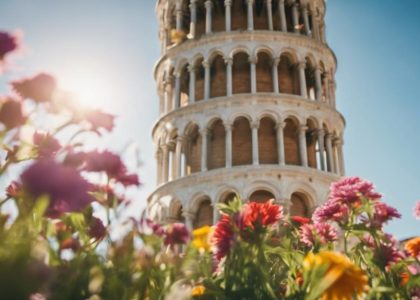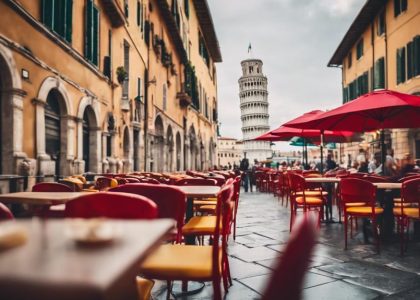The allure of Piazza Dei Miracoli in Pisa extends beyond its picturesque setting; it holds a historical and architectural significance that resonates deeply with visitors. The enigmatic structures within the square have withstood the test of time, each telling a story of a bygone era. Yet, it is not just the physical attributes that make Piazza Dei Miracoli exceptional; its symbolic value to Pisa and the efforts undertaken to preserve its legacy add layers of complexity to its importance. As visitors traverse this iconic square, they are met with a tapestry of history, architecture, and cultural significance that beckons further exploration.
Piazza Dei Miracoli: A Brief Overview
Situated in the heart of Pisa, the Piazza Dei Miracoli stands as a renowned architectural ensemble, showcasing the beauty of medieval Italian art and engineering. At the center of this square lies the iconic Leaning Tower of Pisa, a symbol of both architectural prowess and human fallibility. Surrounding the tower are other masterpieces, including the Pisa Cathedral, the Baptistery, and the Camposanto Monumentale.
The Leaning Tower, originally intended to stand vertically, started tilting during its construction due to a poorly laid foundation. This unintended tilt has now become its most famous feature, attracting visitors from around the world. The Pisa Cathedral, dedicated to the Assumption of the Virgin Mary, is a stunning example of Romanesque architecture, adorned with intricate marble façades and impressive bronze doors.
The Baptistery, known for its acoustics and domed ceiling, served as a place for religious ceremonies. Adjacent to the Baptistery is the Camposanto Monumentale, a monumental cemetery with a vast cloistered interior. Together, these structures create a harmonious architectural complex that represents the cultural and artistic achievements of medieval Italy.
Historical Significance of Piazza Dei Miracoli
The Piazza Dei Miracoli in Pisa holds profound historical significance, embodying centuries of cultural and architectural evolution in Italy.
- Cultural Crossroads: The Piazza Dei Miracoli, also known as the Square of Miracles, stands as a testament to the intersection of diverse cultural influences that have shaped Italy over the centuries. From Romanesque to Gothic styles, the architecture of the square reflects the rich tapestry of Italy's past.
- Religious Symbolism: The historical importance of Piazza Dei Miracoli is deeply rooted in its religious symbolism. The square is home to the iconic Leaning Tower of Pisa, the Cathedral of Santa Maria Assunta, the Baptistery, and the Camposanto Monumentale, all of which have religious significance dating back to the medieval era.
- Architectural Legacy: The structures within Piazza Dei Miracoli represent an architectural legacy that has inspired generations of artists and architects. The intricate designs and innovative construction techniques used in these buildings have influenced architectural styles not only in Italy but also across the world.
Architectural Wonders of Piazza Dei Miracoli
Evidencing exceptional craftsmanship and historical significance, the architectural wonders within Piazza Dei Miracoli epitomize Italy's enduring legacy in architectural excellence. The Leaning Tower of Pisa, a renowned symbol of architectural miscalculation turned masterpiece, stands as the most iconic structure in the square. Its tilted stance, caused by unstable ground during construction, continues to captivate visitors from around the world. Adjacent to the tower, the Pisa Cathedral, a grand Romanesque masterpiece, showcases intricate marble façades, bronze doors, and a stunning dome. The Baptistery, with its harmonious blend of Romanesque and Gothic styles, adds to the square's architectural splendor. The Camposanto Monumentale, a monumental cemetery, completes the ensemble with its elegant cloisters and historical significance. Each of these structures contributes to the unique charm and historical richness of Piazza Dei Miracoli, making it a must-visit destination for those seeking to experience Italy's architectural wonders firsthand.
Piazza Dei Miracoli: Symbol of Pisa
With its collection of awe-inspiring architectural marvels, Piazza Dei Miracoli stands as a symbolic representation of Pisa's cultural and historical significance. The square, also known as the Square of Miracles, encapsulates the essence of Pisa through its iconic structures and historical context. Here are three reasons why Piazza Dei Miracoli is considered a symbol of Pisa:
- Historical Heritage: The buildings within Piazza Dei Miracoli, such as the Leaning Tower, the Cathedral, and the Baptistery, are not only architectural masterpieces but also symbols of the city's rich history and cultural heritage.
- Tourist Magnet: The square's fame and recognition draw visitors from all over the world, making it a symbol of Pisa's international appeal and connection to a global audience.
- Local Identity: For the residents of Pisa, Piazza Dei Miracoli represents more than just a tourist attraction; it serves as a symbol of local pride and identity, reflecting the city's values and traditions.
Preservation Efforts at Piazza Dei Miracoli

Amidst the historical splendor of Piazza Dei Miracoli in Pisa, ongoing efforts are dedicated to the preservation of its iconic structures. The Piazza is home to some of Italy's most renowned architectural treasures, including the Leaning Tower, the Cathedral, the Baptistery, and the Camposanto Monumentale. These structures not only represent exquisite examples of medieval art and architecture but also serve as symbols of Pisa's rich cultural heritage.
Preservation efforts at Piazza Dei Miracoli focus on maintaining the structural integrity of these ancient buildings while safeguarding their historical significance for future generations to appreciate. Conservationists employ meticulous techniques to combat deterioration caused by environmental factors, such as pollution and weathering, ensuring that the Piazza's architectural wonders remain intact.
Furthermore, initiatives are in place to educate visitors about the importance of preserving these cultural landmarks. By raising awareness about the fragility of these structures and the need for sustainable conservation practices, the Piazza Dei Miracoli continues to stand as a testament to Pisa's enduring legacy of art and architecture.





